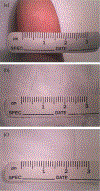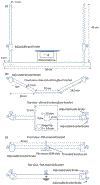Particle transfer and adherence to human skin compared with cotton glove and pre-moistened polyvinyl alcohol exposure sampling substrates
- PMID: 33720803
- PMCID: PMC8276042
- DOI: 10.1080/10934529.2021.1899524
Particle transfer and adherence to human skin compared with cotton glove and pre-moistened polyvinyl alcohol exposure sampling substrates
Abstract
Measurement of skin exposure to particles using interception (e.g., cotton gloves) and removal (e.g., wiping) sampling techniques could be inaccurate because these substrates do not have the same topography and adhesion characteristics as skin. The objective of this study was to compare particle transfer and adherence to cotton gloves, cotton gloves with artificial sebum, and a pre-moistened polyvinyl alcohol (PVA) material with bare human skin (fingertip, palm). Experiments were performed with aluminum oxide powder under standardized conditions for three types of surfaces touched, applied loads, contact times, and powder mass levels. In the final mixed model, the fixed effects of substrate, surface type, applied load, and powder mass and their significant two-way interaction terms explained 71% (transfer) and 74% (adherence) of the observed total variance in measurements. For particle mass transfer, compared with bare skin, bias was -77% (cotton glove with sebum) to +197% (PVA material) and for adherence bias ranged from -40% (cotton glove) to +428% (PVA material), which indicated under- and over-sampling by these substrates, respectively. Dermal exposure assessment would benefit from sampling substrates that better reflect human skin characteristics and more accurately estimate exposures. Mischaracterization of dermal exposure has important implications for exposure and risk assessment.
Keywords: Dermal; exposure assessment; metals; particulate; sampling; sebum.
Conflict of interest statement
Declaration of interest statement
The authors declare that they have no competing interests, financial or otherwise.
Figures



Similar articles
-
A preliminary comparison of three dermal exposure sampling methods: rinses, wipes and cotton gloves.Environ Sci Process Impacts. 2014 Jan;16(1):141-7. doi: 10.1039/c3em00511a. Environ Sci Process Impacts. 2014. PMID: 24281007
-
Development of an Interception Glove Sampler for Skin Exposures to Aromatic Isocyanates.Ann Occup Hyg. 2016 Nov;60(9):1092-1103. doi: 10.1093/annhyg/mew052. Epub 2016 Sep 30. Ann Occup Hyg. 2016. PMID: 27694341
-
Comparisons of computer-controlled chamber measurements for soil-skin adherence from aluminum and carpet surfaces.Environ Res. 2009 Apr;109(3):207-14. doi: 10.1016/j.envres.2008.12.011. Epub 2009 Feb 11. Environ Res. 2009. PMID: 19215916
-
Transfer of contaminants from surface to hands: experimental assessment of linearity of the exposure process, adherence to the skin, and area exposed during fixed pressure and repeated contact with surfaces contaminated with a powder.Appl Occup Environ Hyg. 1999 Apr;14(4):231-9. doi: 10.1080/104732299303007. Appl Occup Environ Hyg. 1999. PMID: 10457645
-
Hand wash and manual skin wipes.Ann Occup Hyg. 2000 Oct;44(7):501-10. Ann Occup Hyg. 2000. PMID: 11042251 Review.
Cited by
-
A review of artificial sebum formulations, their compositions, uses and physicochemical characteristics.Int J Cosmet Sci. 2025 Feb;47(1):168-189. doi: 10.1111/ics.13022. Epub 2024 Sep 9. Int J Cosmet Sci. 2025. PMID: 39246274 Free PMC article. Review.
References
MeSH terms
Substances
Grants and funding
LinkOut - more resources
Full Text Sources
Other Literature Sources
Miscellaneous
